April 18, 2018
Income Inequality and Our Taxes
 Well, it’s that time of the year again, where millions of Americans race to meet the deadline to file their annual tax returns. We have seen a lot of discussions about the tax code, the changes and various opinions as to the benefits and costs of Trump’s new tax plan.
Well, it’s that time of the year again, where millions of Americans race to meet the deadline to file their annual tax returns. We have seen a lot of discussions about the tax code, the changes and various opinions as to the benefits and costs of Trump’s new tax plan.
It’s no surprise that #POTUS has been vocal the last few days about the glory of his tax plan and even #VPPence took to twitter today:

Despite all the administrations gloating, we feel it is quite comical that the federal tax code consists of some 74k pages, yes that’s thousands![1] We have an idea, how bout we get rid of income taxes and just issue bonds. This is a republic, right? Perhaps the people should vote on it, hell the US Government just borrowed $275B in Q1 alone. What is indeed both troubling and interesting at the same time is that Q2 borrowing jumps to $512B nearly double the first quarter amount![2]
So, what would be the difference if we merely added to the treasuries borrowing, another $400B a quarter? It’s not like the principal matters, its just the interest payments we need to cover right??? Furthermore, and what is certainly the biggest scam of all is the fact that individuals paid 5.3x more actual tax than the corporations for FY2017[3].
We are truly reaching the heights of Monopoly money, aren’t we? It seems as if the commoners trivial average wage is a mere footnote on the US Treasuries balance sheet. We hear rumors of so called wage inflation and yet, that seems more conjecture and even hypothetical in fact because, we don’t see it. What we do see is the staggering and certainly unsustainable income inequality that the US is exhibiting. We expect this from some third world banana republic but if the elite globalists think this is going to stand than they have not studied their history very well. In fact, we believe that the populist revolt that elected such a prominent celebrity to the highest office in the land is indicative of the overall concerns of the commoner base. Statista has a great chart of this inequality problem and in fact their latest figures point to the sheer magnitude of this divide, where 87% of the wealth in the United States is owned by 20% of the population. Even more staggering is the fact that the top 1% control nearly 36% of all the wealth:
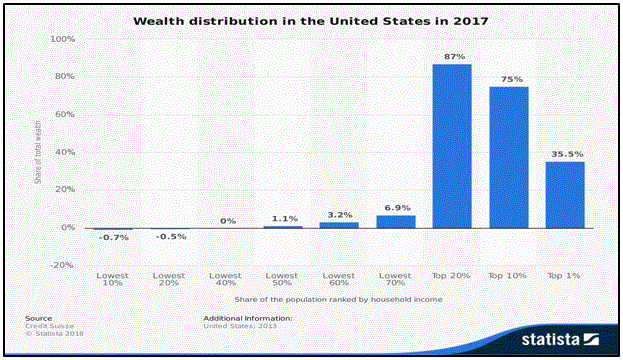
So, we can talk tax remittance and percentages paid and the wealthy can claim they pay 97% of all the taxes but that is why we do not compare nominal amounts. In fact, even comparing percentages when it comes to the top 1% doesn’t make sense because their wealth is so exponentially higher than the average worker that the math doesn’t fit. We are certain of one thing; the data is suggesting that the fiscal and monetary policies do not exhibit general linear models and are in fact directly contributing to this inequality. Yeah, yeah, we will hear arguments till people are blue in the face that its always been Wall Street vs Main Street, but that is not the case. Yes, there have been super wealthy and their opposite extreme poverty, yet this duality has never been this extreme. A democracy and even a republic must recognize that a more equitable distribution will have a greater impact on the social fabric and civil well being of a nation than a hockey stick distribution. Perhaps we are just wishful thinkers, or maybe we just hope logic finds its way into halls of the NY Fed and DC.
The overall equity markets late last week seem to exhibit sell off exhaustion as those seeking protection via going long the VIX hit extremes. When we saw this, we figured where the weak hand was and that’s where it was. So, we thought to ourselves, what would be the easiest course for the equity markets given the extreme weak longs in the VIX? Well to grind higher, slowly but surely. This is exactly what they have been doing. We see some technical resistance at 2711 in the SP futures and we will show a graph later, but we have also seen correlations rise after getting pummeled. We aren’t sold on the fact that the equities are in clear sailing mode once again, rather we know markets never go down in a straight line and bounces, even prolonged ones are natural and necessary. Not even the US bombing strategic positions within Syria could derail the up move, so that was very telling. Oil did run up into Friday as those in the know, must have played the setup game in preparation for hostilities, but, the Trumpster had one thing in mind, send a message and that he did. The strikes were of the limited tactical precision type and they were effective.
We know the fundamental players including ourselves continue to be disgusted with the large QE operations and global debt build. One vocal opponent to all this debt, is Lacy Hunt from Hoisington who continues to pound the pavement regarding this unsustainable debt accumulation. As our readers know, we agree with his position and yes debts contribution to growth is going in the wrong direction. Lacy points this all out in the following,
“In 1952, $3.42 of GDP was generated for every dollar of business debt, compared with only $1.39 in 2017. In the corporate sector, where capital as well as technology is most readily available, GDP generated per dollar of debt fell from $4.50 in 1952 to $2.50 in 2007 to $2.21 last year. The dismal trend in productivity confirms this conclusion. The percent change for productivity in the last five years (2017-2012) was equal to the lowest of all five-year spans since 1952. It was also less than half the average growth over that period.” [1]
One thing is very clear, debt is the new growth and it doesn’t matter, until it does, unfortunately.
Well, its earnings season and Q1 earnings are trickling in and despite the massive rise in 3-month LIBOR from .25% to nearly 2.35% the banks seem to be benefitting. Citigroup reported .08 cents earnings beat on $4.6B in revenue up 13% from last year. They also reported a $3.1B dividend and stock repurchase during the quarter. [2] That is surprising to us, as we figure given the lofty share price, the last thing they should be doing with extra funds is buying back stock! Bank of America also beat expectations as profits rose 30%.[3] We are quite sure the lower tax rate helped as well as the higher interest rates because we all know the rate they receive on their credit and loan repayments and the rate they pay to their customers is at decade wide spreads. Dare we mention their take of the $47B per year in free money from the Federal Reserve for the IOER mechanism??? Good news none the less for investors we suppose.
Also reporting was Netflix as their shares climbed 5% to $323 which puts their overall equity 2018 return near 60%! Their content spending continues to climb, hitting $10B this year, but they continue to add subscribers, 7.4 million in Q1 alone. Free cash flow is projected to stay negative for a few more years. The problem we see with that is twofold for Netflix. One they must continually pay up for content to stay at the cutting edge and second their $24.4B in debt is problematic, higher rates notwithstanding, effectively you eventually must make consistent profits to remain viable and to afford this said debt.
We commented last week in a few blog posts about the buildup of VIX protection and the most likely scenario that this would lead to and that was, a slow grind up in equities. The name of the game today seems to be, sniff out the largest weakest position and force them to the exits, well here is the SP chart (All charts courtesy of Keystone Charts Inc):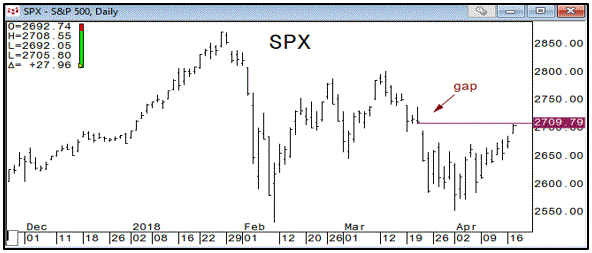
2711 is the Fib 61.8% so we would expect that to stall and offer some short-term players some decent levels to sell into. However, given the technical backdrop, the fundamental earnings picture may provide a continued slow grind higher.
Another thing we pointed out last week was the grind up in the DAX, which may be leading the US equity markets higher, but expect the green MA to have a say so:
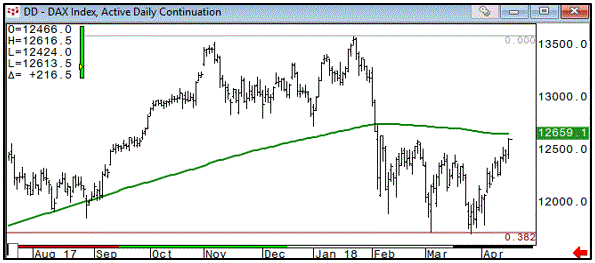
As quickly as correlations broke down, we can see now that the US bond futures market is now following the equity markets higher:
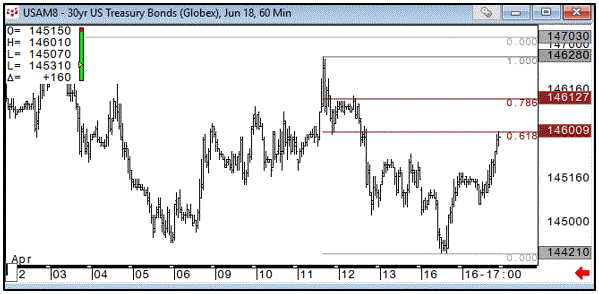
This bond move has the smell of US yield curve flatteners, meaning investors and traders continue to sell the front end of the curve (ED-5yr) and buy longer dated bonds. This flattening of the US Yield curve is widely expected and consistent with the hawkish tone of the Federal Reserve. Zerohedge posted this US 2s30 chart today, you can see the technical damage done to the curve via FED rate hikes as 2s30 hits 61.5 basis points:
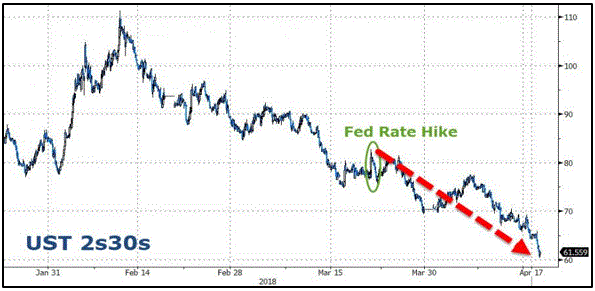
Lastly, we are going to post a Bitcoin chart that we put in last weeks Crypto edition, but we figured it was worth a look here. There was plenty of news coming down the pipes about Soros and Rockefeller getting into the Crypto space. Well as you know, these types of players don’t say anything unless they want you to know and only after they have accumulated a position. Although Bitcoin was running into longer term supports in the low $6500 area, the bounce was in no doubt enhanced by the reports of these wealthy titans getting into the fray. There is also some talk of tax selling finally over and we tend to agree with that notion. As our long-time readers know we are bulls on Blockchain and Bitcoin and we continue to monitor the massive advances in the space, anyway here is the chart:
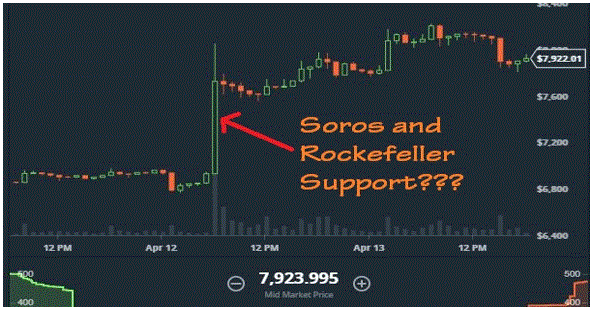
In conclusion we thank you for reading our letter and we hope you were engaged and enlightened. We will continue to monitor the geopolitical events as well as the fiscal and monetary decisions around the globe, speaking of monetary decisions and central banks, is the Swiss National Bank, a hedge fund, a central bank or just a legal counterfeiter? Who knows but their stock has been on fire this year, yes they are a stock as well:
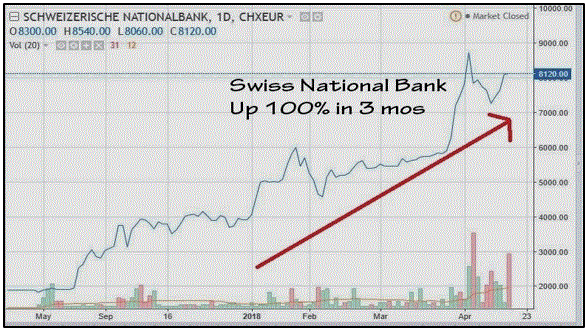
Not a bad gig, printing money and buying private assets, now you can see why the markets can’t fall, the central banks won’t let it! Ok that is it we leave you with weekly settles below, where you can see Crude oil had a great week up over 8% and as usual this year, the US 5yr is the whipping boy, have a great week Cheers!
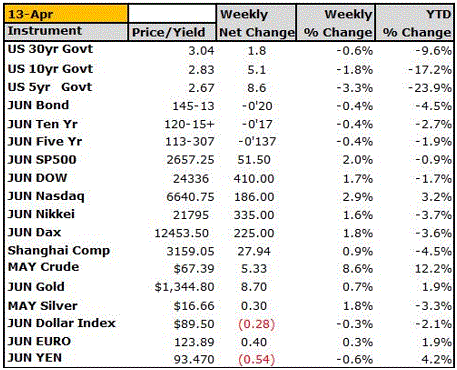
[1] https://www.washingtonexaminer.com/look-at-how-many-pages-are-in-the-federal-tax-code
[2] https://www.treasury.gov/resource-center/data-chart-center/quarterly-refunding/Documents/Q42017CombinedChargesforArchives.pdf
[3] https://www.usgovernmentrevenue.com/
[4] www.hoisingtonmgt.com/pdf/HIM2018Q1NP.pdf
[5] https://www.zacks.com/stock/news/299117/citigroup-c-beats-on-q1-earnings-as-revenues-improve
[6] https://www.zacks.com/stock/news/299242/bofa-bac-beats-on-q1-earnings-and-revenue-estimates
Finally, we will decidedly end our notes with our reaffirmation of the growing need for alternative strategies. We would like to think that our alternative view on markets is consistent with our preference for alternative risk and alpha driven strategies. Alternatives offer the investor a unique opportunity at non correlated returns and overall risk diversification. We believe combining traditional strategies with an alternative solution gives an investor a well-rounded approach to managing their long term portfolio. With the growing concentration of risk involved in passive index funds, with newly created artificial intelligence led investing and overall market iliquidity in times of market stress, alternatives can offset some of these risks.
It is our goal to keep you abreast of all the growing market risks as well as keep you aligned with potential alternative strategies to combat such risks. We hope you stay the course with us, ask more questions and become accustomed to looking at the markets from the same scope we do. Feel free to point out any inconsistencies, any questions that relate to the topics we talk about or even suggest certain markets that you may want more color upon.
____________________________________________________________________________________
Capital Trading Group, LLLP ("CTG") is an investment firm that believes safety and trust are the two most sought after attributes among investors and money managers alike. For over 30 years we have built our business and reputation in efforts to mitigate risk through diversification. We forge long-term relationships with both investors and money managers otherwise known as Commodity Trading Advisors (CTAs).
We are a firm with an important distinction: It is our belief that building strong relationships require more than offering a well-rounded set of investment vehicles; a first-hand understanding of the instruments and the organization behind those instruments is needed as well.
Futures trading is speculative and involves the potential loss of investment. Past results are not necessarily indicative of future results. Futures trading is not suitable for all investors.
Nell Sloane, Capital Trading Group, LLLP is not affiliated with nor do they endorse, sponsor, or recommend any product or service advertised herein, unless otherwise specifically noted.
This newsletter is published by Capital Trading Group, LLLP and Nell Sloane is the editor of this publication. The information contained herein was taken from financial information sources deemed to be reliable and accurate at the time it was published, but changes in the marketplace may cause this information to become out dated and obsolete. It should be noted that Capital Trading Group, LLLP nor Nell Sloane has verified the completeness of the information contained herein. Statements of opinion and recommendations, will be introduced as such, and generally reflect the judgment and opinions of Nell Sloane, these opinions may change at any time without written notice, and Capital Trading Group, LLLP assumes no duty or responsibility to update you regarding any changes. Market opinions contained herein are intended as general observations and are not intended as specific investment advice. Any references to products offered by Capital Trading Group, LLLP are not a solicitation for any investment. Readers are urged to contact your account representative for more information about the unique risks associated with futures trading and we encourage you to review all disclosures before making any decision to invest. This electronic newsletter does not constitute an offer of sales of any securities. Nell Sloane, Capital Trading Group, LLLP and their officers, directors, and/or employees may or may not have investments in markets or programs mentioned herein.
